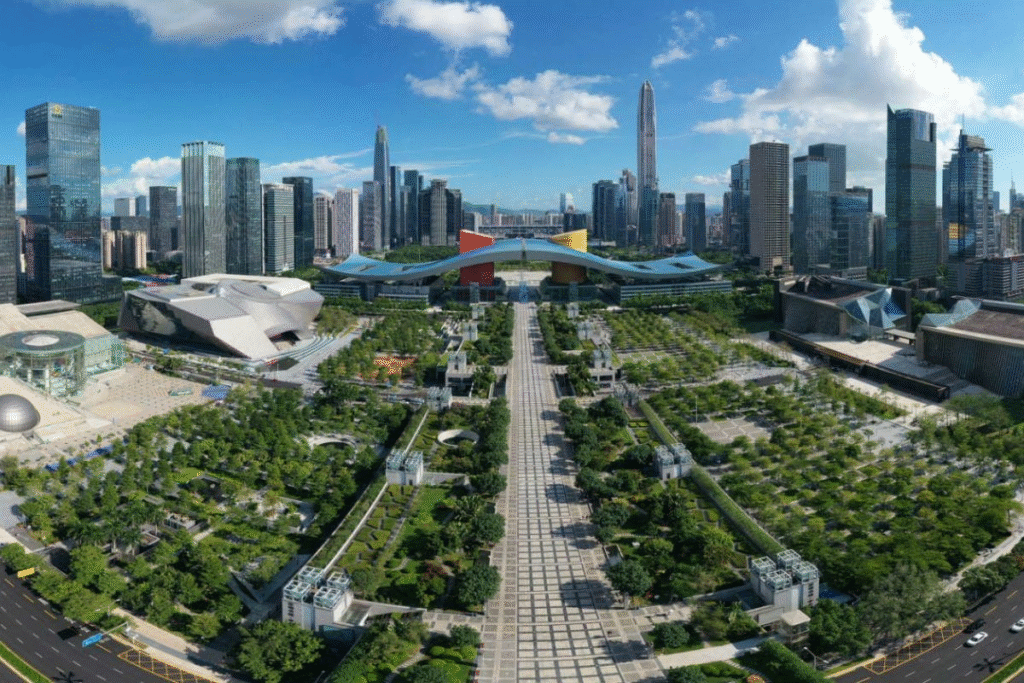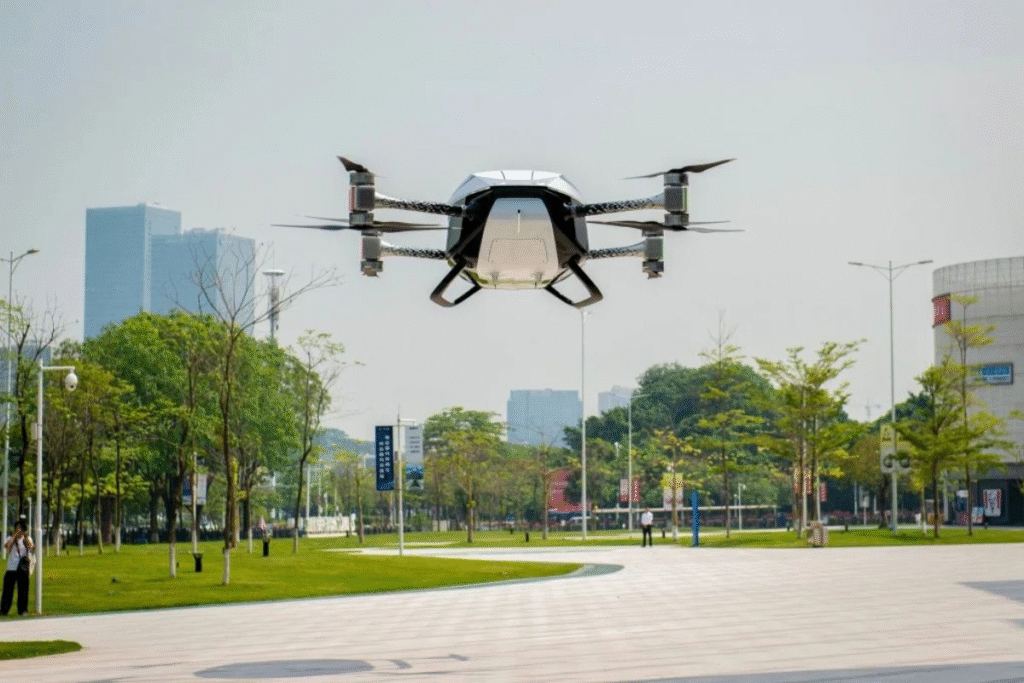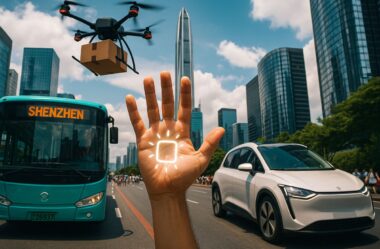Tempo de leitura: 6 minutos
Maria Heloisa Barbosa Borges | Shenzhen, the high-tech urban sanctuary that emerged from special economic zones, boasts 17 million residents and a connected everyday life where citizens pay with the palm of their hand, order delivery via drones, and travel in electric fleets and self-driving cars. A true hidden sanctuary dating back 400 years? No, a living laboratory of the present.
Shenzen has gone from being a fishing village to becoming Shenzen, a showcase for pro-innovation policies and an urban infrastructure where automation and digital services are already routine. The transformation accelerated when the city was designated as a special economic zone, attracting investment and facilitating flexible business models. The result was a megalopolis with approximately 17 million inhabitants and a technological ecosystem that manifests itself in the most mundane everyday life, from tea ordered by drone to subways unlocked with QR codes.
This automated day-to-day life can be seen at the airport, which is taken over by LED panels, on the roads where green signs identify electric cars, and in parks with solar banks that recharge cell phones by induction. In Shenzhen, the promise “smart city” is not a slogan: is a daily practice mediated by applications, sensors and robotics.
Historical context and the economic turning point

The shift began when the government defined Shenzen as one of the first special economic zones. The institutional design opened space for foreign capital, new trade rules, and an incentive regime that enabled factories, R&D centers, and supply chains.
What began as an “experiment” has become a platform for technological production and consumption that today organizes the daily lives of residents.
Sustainability and electric mobility as standard

Em Shenzen, electrification is not a trend, it is the norm. The city displays 100% electric bus fleet, cars with green license plates and an abundant supply of electric models at dealerships.
From the street perspective, the scene is straightforward: most of the vehicles that pass by are electric, and this spills over into the local economy, from logistics to maintenance.
The impact goes beyond zero tailpipe emissions. The massive presence of electric vehicles is reshaping charging services, route planning, and even road design. The quiet operation and quick response of the motors change the travel experience, while the capillarity of charging points sustains the habit.
Drones, lockers and the frictionless last mile

Orders made by QR code start from dedicated drone platforms, which cross areas between buildings, land at pre-defined points in the park and release the package in lockers.
Rain or shine, the system works with pre-planned routes and quick battery changes, maintaining order turnover.
Reverse logistics is also thought out in detail: the packaging is returned to a collection point for reuse. This cycle shows how Shenzen integrates technology, operation and user habit., reducing friction when purchasing and receiving.
Automated restaurants and payments with the palm of your hand

At lunch, the menu opens via QR code, the order enters the system queue and the open kitchen delivers it in minutes.
In convenience retail, payment with the palm of your hand is already linked to the local application, and the reading considers lines and veins to authenticate. Facial recognition and iris verification projects appear in pilots that make the experience even more instantaneous.
The central point is fluidity: fewer queues, less physical money, more integration between identity, account and consumption. The result is a faster, more predictable purchasing cycle, suited to the volume of a megacity.
Autonomous cars in delimited areas
The autonomous mobility of Shenzen operates in georeferenced areas, with apps that call driverless vehicles.
Real experience makes the state of the art clear: there are cars with safety operators in some sections and others completely driverless, obeying traffic lights, dodging buses, slowing down for pedestrians and even honking the horn when necessary.
Boarding is via QR code, the seat belt is a prerequisite for starting the journey and a divider prevents interference with the panel.
This is one pilot in production, where different levels of autonomy coexist. Still, the urban message is unequivocal: Shenzen already lives with the car that drives itself and organizes the space so that it works safely.
Metro by QR code and robotic maintenance
The subway of Shenzen integrates the same digital flow: a QR code in the app releases turnstiles and consolidates the payment. In the transaction, robots responsible for cleaning circulate regularly, maintaining floors and common areas.
The set translates a priority: public service with simple interface and automated maintenance, reducing bottlenecks and operational costs.
Hospitality and messenger robots

After hours, automation arrives in the elevator: robots deliver meals and notify you in your room upon arrival, following internal hotel routes.
The service chain is completed with notifications, confirmation of receipt and automatic return of the robot to base. The 24/7 promise becomes practice, without unnecessary human friction.
Tech brand ecosystem entering the automotive sector
Shenzen houses concept stores where brands born on smartphones display cars with giant screens, inductive charging, massage seats, dimming and even an internal projector.
The showroom is not just a showcase: it is demonstration of integration between hardware, software and services, in which the vehicle becomes an extension of the user’s digital ecosystem.
This movement increases competition and reinforces local logic: who dominates consumer electronics and supply chain can scale to mobility with speed.
Surveillance, data, and the price of efficiency
The other side of the coin is the ubiquity of cameras. In Shenzen, the perception is that monitoring goes beyond “recording” and includes facial recognition, age estimation and expression reading.
Operational efficiency coexists with debates about privacy and data governance, an inherent tension when the entire city becomes an interface.
In this balance, the user experience improves while increasing responsibility for those who collect, process and store information.
Institutional design and transparency of criteria become as strategic as sensors.
From drones to electric buses, from Shenzen clear signs emerge: automation is distributed, not concentrated.
Parks, subways, hotels, restaurants, and public roads function as modules of a larger system. This mosaic operates because processes were redesigned for technology, and not the other way around.
The city, which began as a zone experiment special economic, consolidated a everyday life where the “future” is logistics, payment and transportation working seamlessly.
In practice, the design of urban experience has become applied industrial policy.
In your opinion, should Shenzen’s advance further prioritize the automation of everyday life, or is it time to slow down and discuss privacy limits?
Fonte: Click Petróleo e Gás | Foto: Reprodução







Os comentários foram encerrados, mas trackbacks e pingbacks estão abertos.